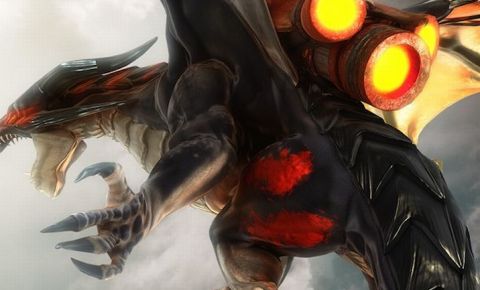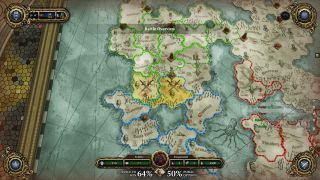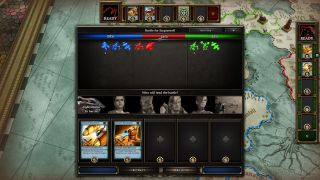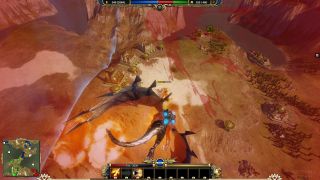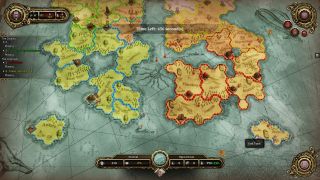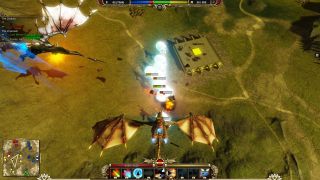The idea is so simple that someone should have already implemented it: put a dragon flapping its wings and belching fire at enemies in the middle of a real-time strategy title and watch the ensuing mayhem.
And don’t forget to strap some jetpacks to the fantasy dragon we are talking about in order to increase its awesomeness quotient.
But so far, the only game I know of that allows players to ride dragons into battle against a mix of fantasy and tech-based enemies is Divinity: Dragon Commander, the new title from developer Larian Studios.
In addition to offering players a chance to breathe fire while flying over the battlefield, the game also brings a very good mix of strategy, card play, resources management and role playing, creating an experience that’s unlike any other title on the market.
Story
There are two ways of experiencing the campaign of Divinity: Dragon Commander: by playing the developer-created story-based campaign or by creating a custom one, which gives players more options related to maps and princesses.
Both game modes are centered around The Raven, a unique flying ship that servers as the base of operations, filled with a colorful cast of characters that players can and need to talk to.
Conversations explain more about the world, which mixes old-school magic and dragons with tech-based battle vehicles, and sometimes players need to make choices that will impact the course of the game.
Five races are represented at court and each of them has very different sets of values and interests, with each decision followed by consequences and more exposition.The writing is decent and the Divinity world feels fresher than that of other strategy games, mainly because the team at Larian Studios chose to make the entire universe colorful and somehow joyous despite the war that’s taking place.
The problems that the various races raise in Council are especially interesting because they are often linked to real-world controversies and can quickly change their opinion of the player.
I have also appreciated the little headlines that pop up in the newspaper based on battle outcomes and the interactions on the Raven, and the overall presentation is charming in itself.
Gameplay
Divinity: Dragon Commander mixes quite a few gameplay mechanics into a coherent experience: a turn-based strategic map, real-time battles, card use and resource management.
At the strategic level, gamers can move their troops around the map, they can purchase more reinforcements, research technologies for their units and their dragons and, more crucially, they can obtain cards.
These come from specialized buildings and, in the campaign, from some choices and a player who wants to be successful needs to use them effectively.
Once moves are plotted and campaign cards are played, turns are processed and where units meet, a real-time battle starts, but not before mercenary and battle advantage cards are played in order to change the balance of forces on the field.
The real-time battles in Divinity: Dragon Commander are built around one resource: recruits, which players need to secure while using their forces in order to take out enemy groups and buildings.The dragon himself can be outfitted with a variety of skills and can only be called on the battlefield after a few minutes but, in good hands, it can be a destructive force.
Gamers need to make sure that they target the enemy where it’s vulnerable and stay clear of rocket-equipped troops and imp fighters in order to make sure that the dragon survives and is effective.
Victory requires a good mix of units, solid use of the various special abilities (meteors, suicides and morphing are the best ones) and the sprinkling of a little bit of dragon assault on top.
The variety that Larian Studios has created means that Dragon Commander has a learning curve, but the single player does a good job of familiarizing players with the options before they jump into more advanced game modes.
The Artificial Intelligence that powers enemy factions does a good job on the strategic map, gathering territories and cards and moving quickly to try to stop any advance on the part of the player.
The A.I. is even more ruthless in skirmish games, where it first moves to take control of all resources and building nodes of the player and then uses a full array of units and special abilities to stop any counterattack, even one led by a dragon.
Those who want a true challenge should play on the Hard difficulty setting. The developers say that no restrictions are applied to the computer opponents, a change that’s clearly visible in their love of the Meteor Shower that the Warlocks can deploy.
The Custom Campaign is extremely varied, with a host of options linked to start resources and rules that can fundamentally change the nature of the game and make Divinity almost infinitely replayable.
Graphics and audio
Divinity: Dragon Commander is a good-looking strategy game and manages to pack a lot of information into its user interface.
The strategic map draws heavily from the look of board games, both when it comes to its layout and to the way units move and cards are played.
Once the game moves to its real-time battle component, the graphics continue to be crisp and colorful, using colored icons for units when zoomed out and showing more of the action when the player zooms in or when the dragon is engaged.
The music is also very well suited to the game, with a mix of classical and rock themes that manage to capture the fantasy and technology-driven world that the player is fighting for.
The voice acting for the various characters could have used a little bit more passion, but I could not help but enjoy the enthusiasm transmitted by my Elf princess or the vulgarity of a Dwarf that I annoyed a little too much.
Multiplayer
Divinity: Dragon Commander becomes an even more interesting game when at least one slot in a multiplayer game is occupied by a human.
Gamers can choose to cooperate in a campaign against computer-controlled opponents (again, for best results, choose Hard enemies) or they can go up against one another, using the various tools that the game offers to destroy armies and capture capitals to force surrenders.
There are hundreds of combinations created when cards abilities, unit powers and the map layout are combined and it’s delightful to see which one an opponent will choose and then think about how it can be countered.There are a lot of maps to try out and the computer-controlled factions also do a good job, both as enemies and as partners.
I have played both a cooperative campaign and a versus one in Divinity: Dragon Commander and I am sure players who have the time and the friends will find it one of the most accomplished strategy experiences of the year.
Every piece of the experience works as intended and the mix of grand strategy, tactical battles, card use and resource management creates a huge number of potential paths to success and almost infinite replayability. The only real problem with Divinity: Dragon Commander is that it requires a bit of time to learn the most interesting and effective strategies and will then tie up even more of a gamer’s time with its obvious quality. The version of Divinity: Dragon Commander I have played might differ slightly from the one that gamers get on launch, as the team at Larian Studios continue to improve the game experience.
The Good
The Bad
Conclusion
 14 DAY TRIAL //
14 DAY TRIAL // 